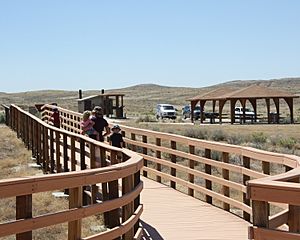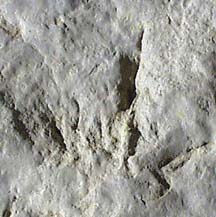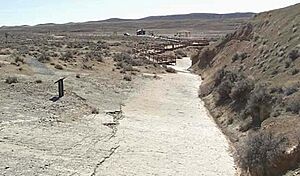Red Gulch Dinosaur Tracksite facts for kids
The Red Gulch Dinosaur Tracksite is an amazing place in Wyoming where you can see real dinosaur footprints! These fossil footprints are found on public land near a town called Shell, in Big Horn County, Wyoming.
A geologist named Erik P. Kvale from the Indiana Geological Survey first found these tracks in 1997. It's like a giant puzzle piece from the past!
The Bureau of Land Management takes care of this special site. It's part of the Red Gulch/Alkali National Back Country Byway, which is a scenic route. The best part is, it's open for everyone to visit and explore.
What Kinds of Fossils Are There?
The fossilized tracks at Red Gulch are super old! Scientists believe they were made about 160 to 180 million years ago. This was during a time called the Middle Jurassic Period. Back then, this area was the shore of a big ocean called the Sundance Sea.
Scientists think some of the tracks were made by Theropod dinosaurs. These were meat-eating dinosaurs, like the famous T-Rex, but much older! However, the evidence suggests that many different types of dinosaurs walked here. It was a busy dinosaur highway! We don't know the exact species of dinosaur that made most of the tracks because Middle Jurassic theropods are quite rare to find. Most of the footprints are in a large area that people call "the ballroom."
Besides the dinosaur footprints, you can find other cool fossils too. These include belemnites (which look like squid pens), crinoids (which are like sea lilies), and even burrows made by ancient shrimp!
How Did the Tracks Form?
The dinosaur tracks are found in a layer of limestone. This rock layer is part of something called the Sundance Formation. Finding dinosaur tracks here was a bit of a surprise! That's because scientists used to think the Sundance Formation was mostly formed underwater in the ocean.
But the tracks show that dinosaurs were walking on land here. Right above the tracksite, there are lots of marine fossils, like shells from an ancient oyster called Gryphaea nebrascensis. This tells us that after the dinosaurs walked across the muddy shore, the area was covered by the ocean again later in the Jurassic Period. It's like a snapshot of a changing ancient world!




